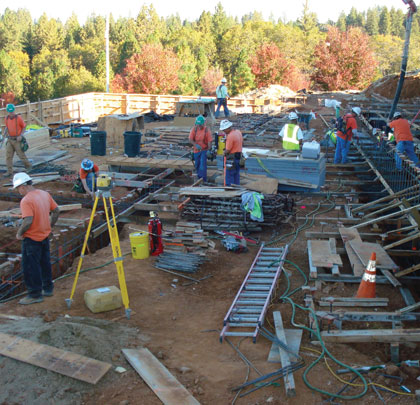On large commercial, industrial, and energy projects in both the public and private sphere, general contractors may require those subcontractors performing significant scopes of work to procure performance and payment bonds in addition to the bonds that the general might itself be required to obtain. Performance bonds are procured to alleviate some of the risk on non-performance or defective performance that the general would otherwise be assuming vis-à-vis the owner. Assuming you’ve made the decision to require these bonds, what do you, the general contractor, need to do to secure surety performance in a subcontractor default situation?
PROVISIONS
The first thing to remember is that the surety’s obligations on the performance bond are predicated upon the subcontractor’s default. Thus, protecting your interests in the project begins with a carefully worded and clearly defined subcontract provision governing default. The default provision should be specific as to events of default and the process for declaring a default against the offending subcontractor.
Additionally, a clear termination provision should be included in the subcontract. This provision will be beneficial for both election of remedies against a defaulting subcontractor, as well as triggering the surety’s obligations under the performance bond. Essentially, that trigger is the first step towards securing surety performance.
SURETY PERFORMANCE
Assuming the subcontract has these provisions, what should you do in the event of subcontractor default? To start, clearly laying out the relevant facts that establish default in a letter to the subcontractor and surety is essential for both entitlement to available remedies and preservation of claims. Also, if securing surety performance is a goal, it will likely be necessary to terminate the subcontractor to trigger a surety’s obligations to perform under the bond. If the goal is merely having the financial security of a surety’s continuing performance bond obligations for potential post-project dispute resolution, then termination may not be necessary.
When evaluating the likelihood of surety performance, one must keep in mind that the surety has rights and will likely have defenses available to it that it will use to limit its exposure to risk and liability. First, it is likely that the subcontractor will challenge a declaration of default as improper. The surety may adopt this defense and refuse to perform because, as it claims, the subcontractor did not actually default on its performance obligations. This defense illustrates the importance of specifically listing and citing the events of default that are the basis of the declaration of default and termination.
Also be aware that any possible prior material breach that you may have committed may provide an additional defense to the performance bond obligations and release the surety of its obligations. In situations where a subcontractor claims delay, disruption, or interference as a defense to default, the surety may assert the same defenses. For example, in those situations, the surety may cite one of the following defenses as a reason for the default or failure of performance leading to the demand: (a) failure to provide adequate plans and specifications; (b) design defects; (c) unforeseen conditions; (d) impossibility of performance; (e) concurrent delay; or (f) interference.
SURETY DEFENSES
Separately, sureties also have defenses available specifically to them. These defenses can be asserted in addition to the shared subcontractor/surety defenses and can discharge the surety’s obligation under the bond regardless of the subcontractor’s default. The surety may claim that the scope of the project materially changed during the project. Since the bond was written to guarantee performance of the original contract, a material change in scope provides a defense to the surety because it only underwrote a guarantee of performance as originally anticipated. Another defense might arise if the general contractor or owner has materially deviated from the contractual payment provisions. If there has been a significant underpayment or overpayment, the surety’s rights may have been prejudiced. Such prejudicial conduct might reduce or alleviate the surety’s performance obligations.
Bear in mind that when a subcontractor has been terminated and demand has been made to the surety for performance, the surety will first seek the opportunity to investigate the claims made, the status of the project, and the relevant documents in the project file. All this and the need for the surety to evaluate its potential liability and obligations under the bond take time. If time is not available, then reserving your rights against the surety, while hiring a replacement contractor, must be done.
CONTRACTUAL RIGHTS
Finally, as the beneficiary of the performance bond obtained by a subcontractor, your company will have direct contractual rights against a surety that chooses not to perform when a default has occurred. As such, you have the right to the relief provided by your subcontract agreement. Virtually all surety bonds incorporate the terms of the underlying contract into the bond. Therefore, the remedies and dispute resolution procedures you put into your subcontract will determine your rights against the defaulting subcontractor and will also impact your rights against the surety. Carefully review and revise the subcontract for any additions or deletions that may be necessary for those projects that require bonding. Your rights to correct or complete a defaulting subcontractor’s work begin and end in that subcontract. Your rights against the surety also start with that subcontract. Awareness of these facts will assist your company in protecting its interests and managing its risks on your projects. ■
About The Author:
Jeffrey S. Chapman is a shareholder with Ford Nassen (www.fordnassen.com), which is nationally recognized in the construction industry and one of the largest construction law firms in Texas. Chapman practices construction law with a focus on the litigation and resolution of construction disputes. In addition, he regularly assists clients in preparing and negotiating contracts and other procurement documentation. He can be reached at jschapman@fordnassen.com or 512.275.1782.
_________________________________________________________________________
Modern Contractor Solutions, August 2013
Did you enjoy this article?
Subscribe to the FREE Digital Edition of Modern Contractor Solutions magazine.

Subcontractor Default & Surety Performance


